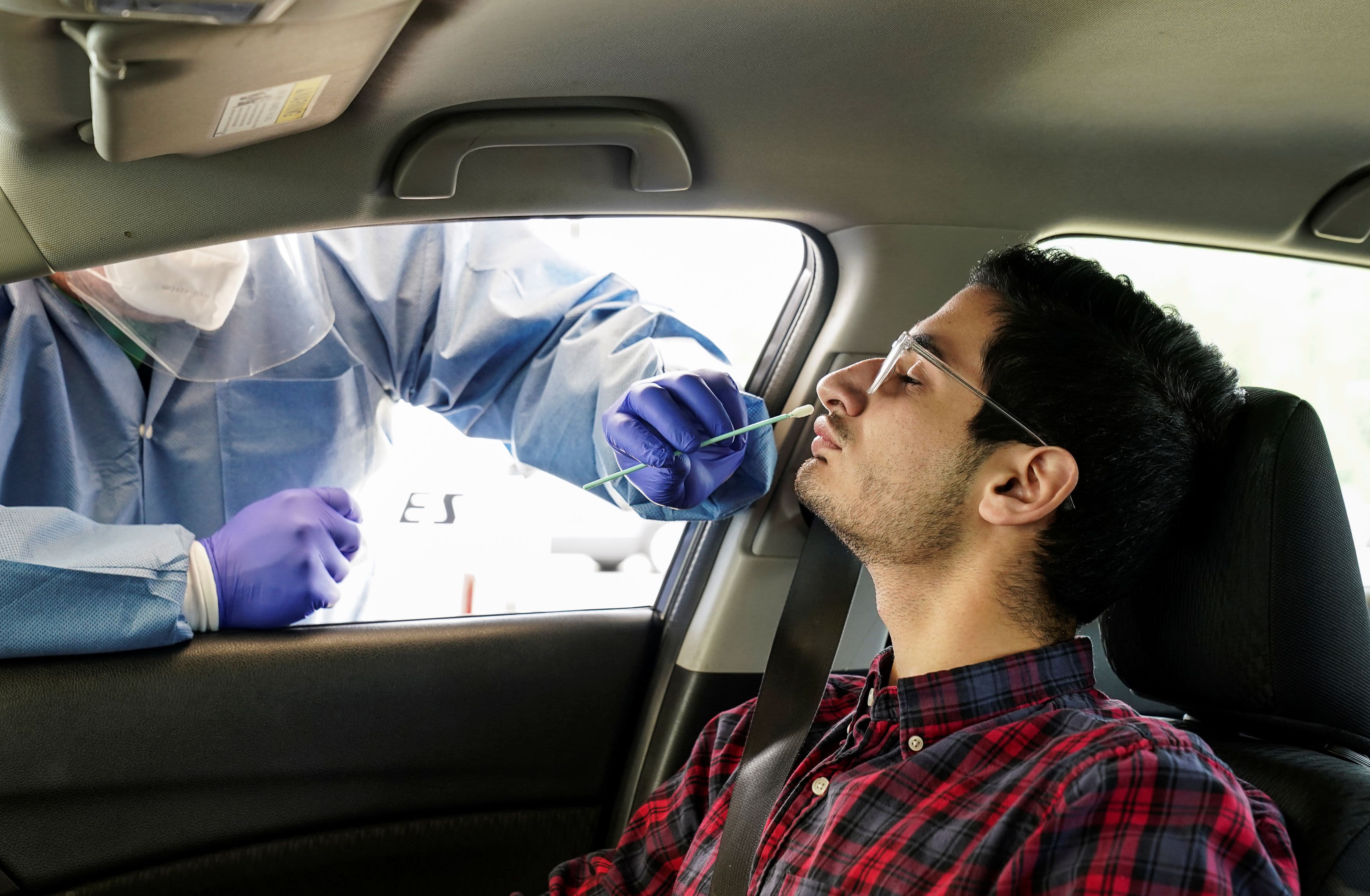
A worker administers a test to a passenger at a drive-through site to collect samples for coronavirus disease (COVID-19) pandemic testing in Leesburg, Virginia, May 20, 2020.
Kevin Lamarque | Reuters
One of the components of contact tracing programs public health experts deem critical to controlling the Covid-19 outbreak includes finding and testing close contacts of known positive cases.
In terms of Covid-19, the U.S. Centers for Disease Control and Prevention defines a close contact as anyone who was within 6 feet of an infected person for at least 15 minutes starting two days before the onset of symptoms until the time the patient is isolated. For asymptomatic patients, or those who don't show symptoms, it would be anyone in contact with them two days before a positive specimen was collected, the CDC advises.
Family members under the same roof or close acquaintances usually fit the bill, public health and infectious disease experts say. However, coming into contact with the coronavirus can be much more nuanced, especially as large gatherings have resumed in cities across the nation where people from different regions might assemble in close proximity, increasing the risk of transmission.
"People like to think in terms of light switches of on and off, risk or no risk, but the truth is it's a dimmer switch," said Dr. Greg Poland, an infectious diseases expert and head of Mayo Clinic's Vaccine Research Group. "The more people you come into contact with, the higher the probability of coming in contact with someone who's infected."
Mass gatherings and Covid-19 exposure
Someone who attended a large gathering doesn't necessarily meet the general definition of a close contact, Dr. Mike Ryan, executive director of the World Health Organization's emergencies program, said during a press conference at the agency's Geneva headquarters on June 8.
However, there may be situations where public health officials, out of an abundance of caution, could advise people to either quarantine or get tested, he said.
"There are any number of actions that could be taken, but by the strict definition of what risk is in the context of Covid-19, the riskiest situation to be in is to be in close proximity to a case, particularly a symptomatic case of Covid-19," Ryan said.
There are a number of high-risk situations that could increase your likelihood of Covid-19 transmission, experts say. Attending a large gathering for a prolonged period of time where people may not be wearing face coverings and are in close proximity would be considered higher risk.
Indoor gatherings with less air circulation are also considered higher risk than outdoor, experts say.
Context also has to be considered when attending mass gatherings, such as the nationwide protests for the police killing of George Floyd, an unarmed Black man, where people could be chanting while not wearing masks, said Dr. Amesh Adalja, a senior scholar at the Johns Hopkins University Center for Health Security.
Scientists know the coronavirus can spread through respiratory droplets that pass when an infected person coughs, sneezes or even breathes. The droplets of infected fluid can land on nearby surfaces like desks, tables or telephones and infect anyone who touches them.
"These are not just people sitting quietly outdoors listening to a Mozart concert. There is screaming, chanting, yelling. They're being sprayed with pepper spray and tear gas, all of which increase the transmission risk," Adalja said.
Adalja also said the 15 minute mark outlined by the CDC isn't necessarily a magic number and transmission can be possible in a shorter time frame, but the figure is typically used to determine where the most value would be derived during a contact tracing investigation, he said.
Where you live in the U.S. could also increase your risk as some states, like those in the West and South, report record-breaking daily new cases figures.
It wouldn't be a bad idea to get tested if you attended an event where Covid-19 cases were increasing, especially if tests are easily accessible, said Dr. Preeti Malani, chief health officer and professor of medicine and infectious disease at the University of Michigan.
Malani added that testing people at gatherings could also help public health experts determine what local transmission is like in the area. You should absolutely be tested if you went somewhere and begin developing common symptoms, like a cough, fever or shortness or breath, she said.
When should you be tested?
The best time to know whether you were infected with Covid-19 during an event would be several days after, Adalja said. Otherwise, you could still test positive, but it would take further examination to determine whether you were infected before or after a certain event.
"If you just get tested four days afterward, you could've still been incubating it, it's not necessarily you got it there, so you have to look at the timeline," he said.
Studies suggest that the virus can be undetectable within the first few days of infection, depending on the test. Research also shows that it can take anywhere from five to 12 days for people to show symptoms from the coronavirus.
Ravina Kullar, an adjunct faculty member at the University of California Los Angeles and a member of the Infectious Disease Society of America, suggests anyone who attends a mass gathering or protest quarantine for a few days before getting a test.
"You need a high enough viral load for the test to pick it up and in those early days, one to two days, has been shown to not be that accurate," Kullar said.
"come" - Google News
June 20, 2020 at 09:59PM
https://ift.tt/3djKgSa
What it means to come into close contact with a coronavirus case and your risk of infection - CNBC
"come" - Google News
https://ift.tt/2S8UtrZ
Shoes Man Tutorial
Pos News Update
Meme Update
Korean Entertainment News
Japan News Update
Bagikan Berita Ini














0 Response to "What it means to come into close contact with a coronavirus case and your risk of infection - CNBC"
Post a Comment